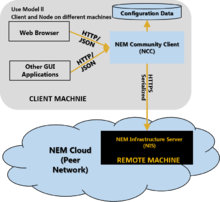NEM (cryptocurrency)
| NEM | |
|---|---|
 | |
| Denominations | |
| Subunit | |
| 0.000001 | µXem (microXem) - smallest unit |
| 0.001 | mXem (milliXem) - thousandth unit |
| Plural | XEM |
| Symbol | XEM |
| Demographics | |
| Date of introduction | 2015 |
| User(s) | Global |
| Issuance | |
| Issuer |
Fixed Decentralized peer-to-peer consensus |
| Website | NEM |
| Valuation | |
| Genesis Block Production | Fixed 8,999,999,999 XEM total |
|
Block time 1 minute Technology Blockchain | |
NEM is a peer-to-peer cryptocurrency launched on March 31, 2015[1] and written in Java.[2] NEM has a stated goal of a wide distribution model and has introduced new features in blockchain technology in its proof-of-importance (POI) algorithm. NEM also features an integrated P2P secure, multisignature accounts and encrypted messaging system and an Eigentrust++ reputation system. NEM technology is used in the private blockchain Mijin being tested by financial institutions and private companies in Japan.[3]
History
NEM was started by a Bitcoin Talk forum user called UtopianFuture after having been inspired by Nxt and wanted to improve upon it. Starting on January 19, 2014, an open call for participation began on the Bitcointalk forum. The goal was to create a community-oriented cryptocurrency from the ground up.[4]
Development
NEM has gone through extensive open alpha testing starting June 25, 2014, followed by lengthy and comprehensive beta testing starting on October 20, 2014.
The NEM developers are partially pseudonymous.[5]
Unique features
Code
NEM is a new code base that was written entirely in Java. It uses the POI (proof-of-importance) algorithm instead of POW (proof-of-work). NEM uses a client–server model where the NIS (NEM Infrastructure Server) runs independent of the NCC (NEM Community Client).[6]
Although the NEM client is open source and available on github,[7] the NEM server based component, the NIS, is closed source and the binary is obfuscated to presumably prevent decompilers from revealing how it works.
Node Reputation System
NEM is the first cryptocurrency to employ Eigentrust++ as a reputation system. Whereas other cryptocurrencies might use systems like proof-of-work to ensure the health of the blockchain, NEM does this by monitoring past behavior of nodes within the network. In proof-of-work, the amount of work a node does is used as a measure for its ability to protect the network. But, with Eigentrust++, it is the quality of work that is important. This adds to the NEM network's ability to be run and maintained efficiently.[8]
Proof-of-Importance
POI is the algorithm used in NEM to time stamp transactions. A NEM user's importance is determined by how many coins they have and the number of transactions made to and from their wallet. POI is built to exploit the information-rich transaction graph taking into account the NCDawareRank[9] network centrality measure; the topology of the graph; as well as a number of other relevant signals.[10] POI is different from other initiatives which use a fee-sharing model that does not take into consideration one's overall support of the network. In some proof-of-stake systems a person only needs to have large amounts of coins to form a block; however, in NEM the transaction amount, as well as support of the network, become a factor. This has been designed to encourage users of NEM to not simply hold NEM but instead actively carry out transactions within the NEM ecosystem.[11]
Architecture

NEM's design architecture consists of two components. One is the Node server or NEM Infrastructure Server (NIS). The other is the NEM Community Client (NCC). The NIS is connected to the P2P network and acts as a gateway for the NCC. The NCC is basically a client software that includes a wallet. Both the NCC and NIS can be configured to run off the same machine. As it is run from the same machine, both the NCC and the NIS will be exposed to the Internet. A second use case is to separate the NIS from the NCC.[12]
The NIS can thus be configured to act as an additional layer of protection to the NCC thereby making the NCC reasonably protected within its own confines as it can be made not to connect to the Internet. In addition, one can have the option of putting a firewall between the NCC and the NIS, the NCC is therefore two steps away from the Internet. This means that the NCC can be made to work in stealth mode. This type of modular design makes the NCC insulated from external attacks. It is almost impossible to break into the NCC if the NCC is only connected to the NIS through another firewall. If there is any attack on the wallet, it is almost certain that the attack is from within the network rather than from outside the network. Another feature of this architecture is that the NCC acts as a wallet and can be used on any computer, whereas the NIS represents a node on the NEM network and can be hosted from remote locations. Additionally, the client can be loaded onto any computer and a person's wallet can be reloaded as long as this person has his private key.[13]
The NIS can be placed on a Demilitarized Zone (DMZ) behind a firewall and therefore itself is protected from the Internet. Hence, there exists many options and configurations. This makes NEM's architecture designed to be secure.
NEM uses Supernodes as a means to improve the service level and to form a backbone of support for light wallets, mobile wallets, and 3rd party apps. These Supernodes provide better access to the NEM Blockchain so that users can get to the network easily, quickly, and reliably without having to sync to a blockchain locally. Running a Supernode is remunerated with a daily payout in XEM, NEM's currency token.[14]
Multisig
NEM implements multisig (short for multi-signature) technology as an integral part of its platform. The benefit of multisig is that it requires more than one user to sign a transaction. Specifically, NEM implements m of n multisig, where m ≤ n. Put in another way, m out of a total of n signatories must sign a transaction before it can be broadcast onto the blockchain. NEM's multisig works by making a contract on chain so that the "m" accounts have full transnational privileges over the account that has been turned into a multisig account. Since the contract metadata is on chain, it can easily be updated by adding or subtracting additional signers.[15]
Multisig is a technology for enhanced wallet security. Multisig requires that another user or users sign a transaction before it can be broadcast onto the blockchain. This means that if one loses the wallet through a hack, no money can be spent unless another wallet (or wallets if m is more than 2) signs it. Multisig also helps protect community-held funds, in that a majority of designated users must agree before a transaction can be spent from a community-held wallet. This is useful, for example, for fundraising or for other community-oriented financing in order to prevent one rogue community leader from stealing funds over which he or she has been given control.
Tech Bureau Partnership
Mijin
Mijin is a private blockchain based on NEM technology and utilizing the same APIs. It is being designed to decrease the costs for banking institutions by 90% while at the same time increase security.[16] It was tested by Japan's largest trust bank, SBI Sumishin Net Bank, owned by Sumitomo Mitsui Trust Holdings, to add to their online banking services.[17] Additionally, Sakura Internet has teamed of with Tech Bureau to offer 6 month free trials of Mijin.[18] Mijin is also being tested by Infoteria in its enterprise software Asteria.[19] In December 2015, the Japanese SBI Sumishin Net Bank, commissioned NRI, a leading research group in Japan to conduct a test of the NEM blockchain technology Mijin. They tested 2,500,000 accounts with over 2,000,000 transactions per day with a variety of transactions over a three-months period. The network passed further stress tests measuring its availability and fault tolerance. This is one of the first times that a financial institution has publicly released results from independent blockchain tests.[20]
Catapult
In April 2016, Tech Bureau, which also operates one of the country’s largest cryptocurrency exchanges, Zaif, formalized a partnership with NEM by announcing that both Mijin and NEM will share the technology codenamed Catapult. Catapult has been in development since early 2016 and is an enhanced version of NEM/Mijin written in C++ and designed to increase throughput, flexibility, stability, optimization of network communication, and scalability, offering better network performance.[21] Following this announcement, Tech Bureau then announced it closed its Series A financing round raising $6.2 million.[22]
References
- ↑ Beikverdi, Alireza. "NEM Launches, Targets Old Economy with Proof-of-Importance". Coin Telegraph. Coin Telegraph. Retrieved 1 April 2015.
- ↑ "GitHub - New Economy Movement". GitHub. Retrieved 4 January 2015.
- ↑ Maras, Elliot. "Japanese Financial Institutions Partner With Technology Startups To Utilize The Blockchain". CryptoCoinsNews. Retrieved 21 December 2015.
- ↑ Mikha, Sean. "How I Got $1500 for Commenting On an Article". Lets Talk Bitcoin. Retrieved 4 January 2015.
- ↑ Tanzarian, Armand. "An Introduction to the New Economy Movement". Cointelegraph. Retrieved 4 January 2015.
- ↑ Lombardo, Hans. "NEM Q&A – Original, Tested Blockchain Platform, Proof-of-Importance, "Change the World, Forever" Tech". allcoinsnews. Retrieved 9 April 2015.
- ↑ "NEM client published source code".
- ↑ Pangburn, DJ. "This Cryptocurrency Doesn't Want to Beat Bitcoin, It Wants to Beat the Economy". Motherboard. Retrieved 4 January 2015.
- ↑ Nikolakopoulos, Athanasios N.; Garofalakis, John D. "NCDawareRank: A Novel Ranking Method That Exploits the Decomposable Structure of the Web". Proceedings of the Sixth ACM International Conference on Web Search and Data Mining, WSDM 2013. ACM: 143–152. doi:10.1145/2433396.2433415.
- ↑ "NEM Technical Report" (PDF). pp. 30–47. Retrieved 1 September 2016.
- ↑ Beikverdi, Alireza. "Proof-of-Importance: How NEM is Going to Add Reputations to the Blockchain". Coin Telegraph. Retrieved 13 March 2015.
- ↑ Lombardo, Hans. "NEM Q&A – Original, Tested Blockchain Platform, Proof-of-Importance, "Change the World, Forever" Tech". allcoinsnews. Retrieved 9 April 2015.
- ↑ Admin. "New Economy Movement (NEM) – Cryptocurrency 2.5". Cryptoland. Retrieved 4 January 2015.
- ↑ Rene B. "New Economy Movement (NEM) – The Supernodes Program". NEM.IO Supernodes. Retrieved 25 September 2016.
- ↑ OConnell, Justin. "Blockchain Project Thinks Microsoft Azure License Agreement Goes Too Far". CCN. Retrieved 18 April 2016.
- ↑ Holmes, B. "Japanese Company, Tech Bureau, Launches Private Blockchain Project". Bravenewcoin. Retrieved 21 December 2015.
- ↑ Rizzo, Pete. "Japan's SBI Sumishin Building Blockchain Banking Proof-of-Concept". Coindesk. Retrieved 21 December 2015.
- ↑ Redman, Jamie. "Mijin: 'Offering Blockchains To The World for Free'". The Bitcoinist. Retrieved 21 December 2015.
- ↑ Asayama, Takao. "Infoteria Announces Collaboration with Private Blockchain Startup Tech Bureau". prweb. Retrieved 21 December 2015.
- ↑ Buntinx, JP. "Japanese Bank Acknowledges Mijin Blockchain Infrastructure Test". Bitcoinist. Retrieved 18 April 2016.
- ↑ Dob, Daniel. "Tech Bureau partners up with NEM for new blockchain engine". The Merkle. Retrieved 10 June 2016.
- ↑ Fletcher, Katherine. "Japanese blockchain firm Tech Bureau raises $6.2 million". CoinReport. Retrieved 10 June 2016.